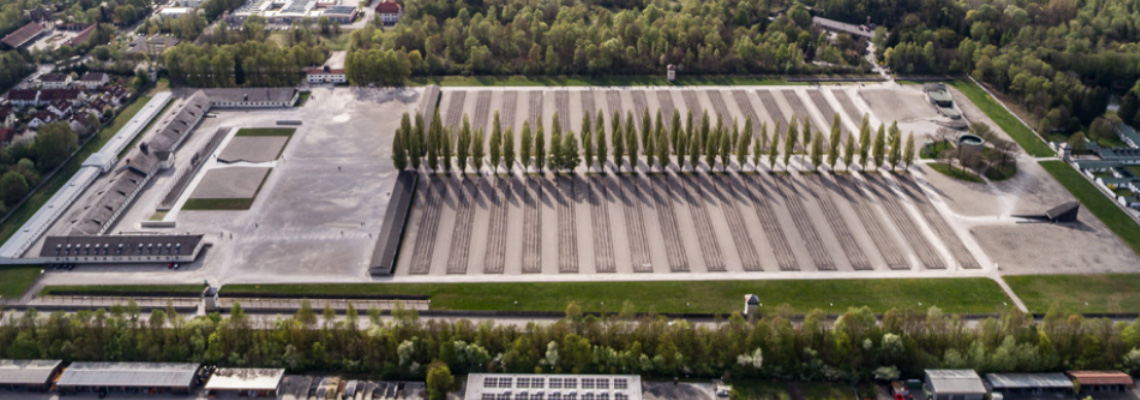The Dachau Concentration Camp Memorial Site, 1945 – today
April 1945 – June 1945
The camp grounds are used to house former prisoners who are sick and unable to return to their onetime homeland or are waiting to be repatriated. The U.S. government provides them with food and medicine.
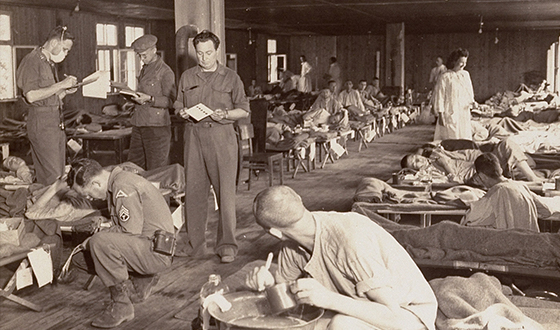
U.S. soldiers look after former prisoners suffering from typhus, April/May 1945 (USHMM)
July 1945 – summer 1948
The U.S. military uses the former SS camp and the former prisoners’ camp for the internment of Nazi party officials and members of the SS. The Dachau Trials take place on the grounds of the former SS camp; 489 trials are held, hearing 672 indictments, before American military courts.
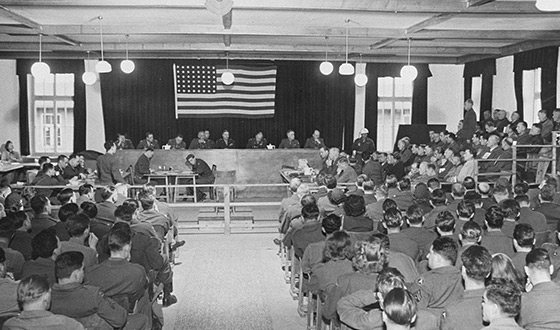
Courtroom during the Dachau Trials, December 1945 (USHMM)
1948
The U.S. military authority returns the grounds of the former prisoners’ camp to the Bavarian state. A reception camp for expelled Germans is built that is later called the “Dachau East residential estate”.
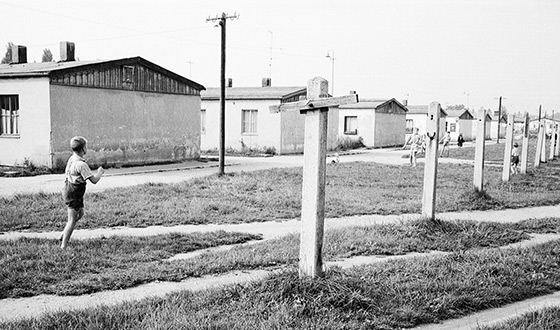
Children playing in the Dachau East residential estate, 1963 (Dachau Concentration Camp Memorial Site)
1955
The International Camp Committee reforms as the Comité International de Dachau (CID). A supplementary agreement to the Paris Treaties places the graves of victims of the Nazi regime under special protection. This prevents the planned imminent demolishing of the former crematorium from going ahead.
1959
An advisory board, comprising representatives from public institutions and associations whose members almost entirely come from the circle of former victims, joins the CID in demanding the creation of a memorial site.
1960
Johannes Neuhäusler, auxiliary bishop of Munich, has the Mortal Agony of Christ Chapel built on the grounds of the former prisoners’ camp; the chapel is consecrated during the Eucharistic World Congress with 50,000 persons in attendance.
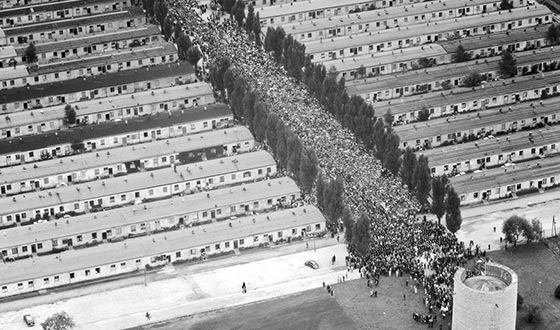
Consecration of the Mortal Agony of Christ Chapel, August 5 1960 (Luftbildverlag Bertram)
1962
The CID and the Bavarian state government agree to create a memorial site on the grounds of the former prisoners’ camp. Demolition work on the barracks – dilapidated and greatly altered by the various uses since 1945 – commences and two replicas are built. In addition, it is planned to repair the walls and guard towers.
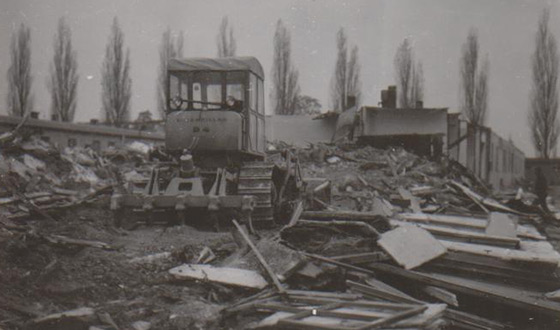
Demolition of the barracks, November 2 1964 (Dachau Concentration Camp Memorial Site)
1964
Johannes Neuhäusler consecrates the Carmelite Precious Blood of Christ Chapel on November 22 1964.
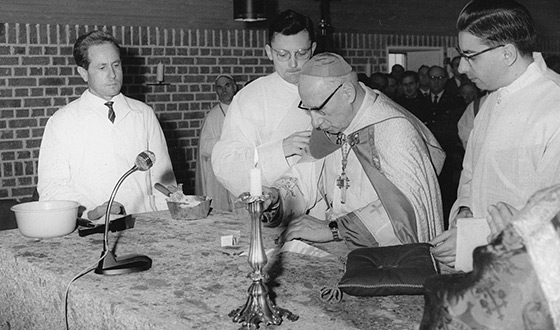
Consecration of the convent church by Johannes Neuhäusler (center), November 22 1964 (archives Karmel Dachau)
1965
On May 9 1965 the Dachau Concentration Camp Memorial Site, which includes a new documentary exhibition, is opened.
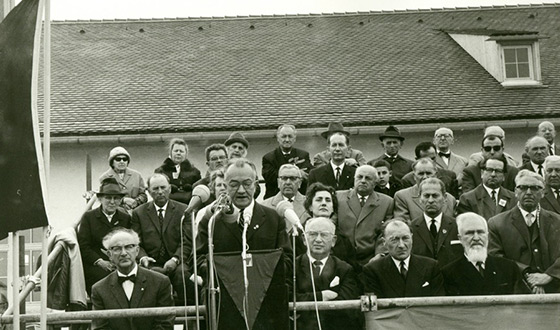
Address given at the opening of the Dachau Concentration Camp Memorial Site, May 9 1965 (CID)
1967
The Bavarian Regional Bishop Hermann Dietzfelbinger consecrates the Protestant Church of Reconciliation on April 30 1967. The Jewish memorial is consecrated by Rabbi David Spiro on May 7 1967.
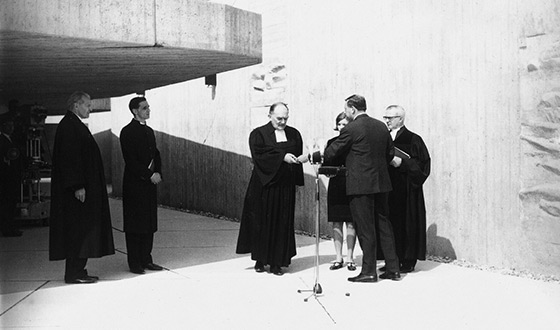
In front of the entrance to the Church of Reconciliation the architect Helmut Striffler hands over the key to Bishop Kurt Scharf (center), chairman of the Council of Evangelical Churches in Germany. (Keystone)
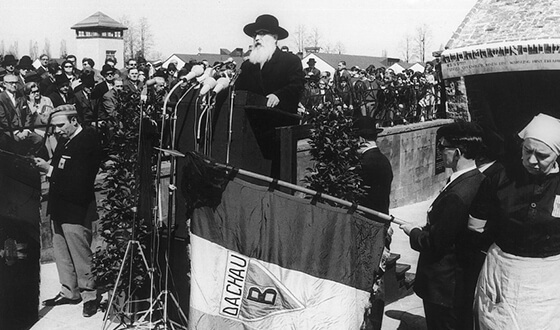
Rabbi David Spiro (center) recites prayers for the dead at the consecration of the Jewish memorial, May 7 1967 (dpa)
1968
On September 8 1968 the International Monument by Nandor Glid is unveiled. The sculptor, persecuted in his homeland Yugoslavia by the Nazis because of his Jewish background, had won an artists’ competition held by the CID.
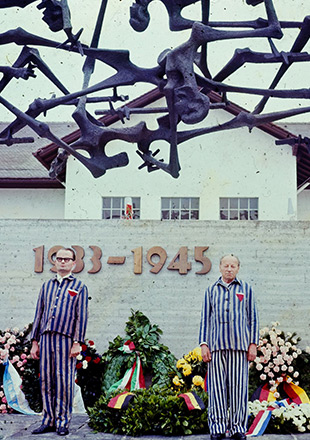
Consecration of the International Monument by former prisoners, September 8 1968 (Danile Gordana and Gabriel Glid)
1975–1985
The Memorial Site develops more and more into a place of political and civic education. “Forgotten” victim groups – such as Sinti and Roma, Jehovah’s Witnesses, and homosexuals – make their voices heard. In the spring of 1980 a group of Sinti and Roma go on a hunger strike to demonstrate against ongoing discrimination.
1995
Public interest in the fate of the victims and the work of the Memorial Site increases steadily with the fiftieth anniversary of the liberation of the Dachau concentration camp. A scholarly advisory board is given the task to elaborate a new concept for the Memorial Site. On April 29 1995, the metropolitan of Nizhny Novgorod and Arzamas, Nikolai Kutepov, consecrates the Russian Orthodox chapel.
2001
A section of the new exhibition is opened in the former camp prison/the “bunker”.
2003
On May 2 2003 the new main exhibition, located in the former maintenance building, is opened. The exhibition follows the leitmotif of the “path of the prisoners”.
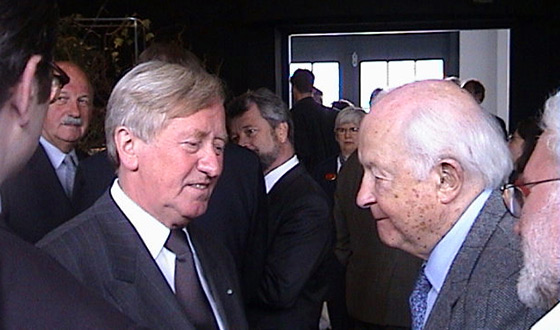
The Culture Minister Hans Zehetmair (l.) with the survivor Hans Taschner (r.) at the opening of the main exhibition of the Dachau Concentration Camp Memorial Site, May 2 2003 (Dachau Concentration Camp Memorial Site)
2005
To mark the sixtieth anniversary of the liberation of the Dachau concentration camp, the entrance to the Memorial Site is adapted to fit the actual historical circumstances. Visitors can now enter the grounds through the Jourhaus, the entrance gate to the onetime prisoners’ camp.
2009
The new Visitors’ Center is opened on April 29 2009.
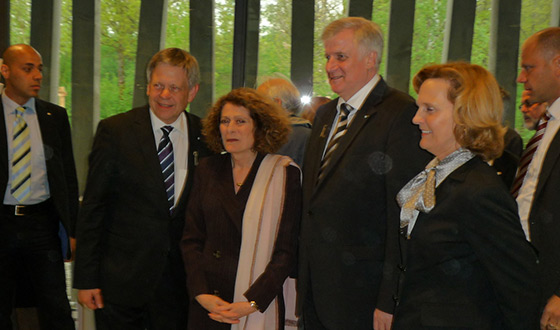
Foundation director Karl Freller, Rachel Salamander, owner of the Literaturhandlung bookstore, Minister President Horst Seehofer and Karin Seehofer at the opening of the new Visitors’ Center (from left to right), April 29 2009 (Dachau Concentration Camp Memorial Site)
2014
On the night of November 1-2 2014, unknown persons steal the historical postern with the inscription “Arbeit macht frei” (“work sets you free”) from the Jourhaus gate. It is replaced by a replica the following year.
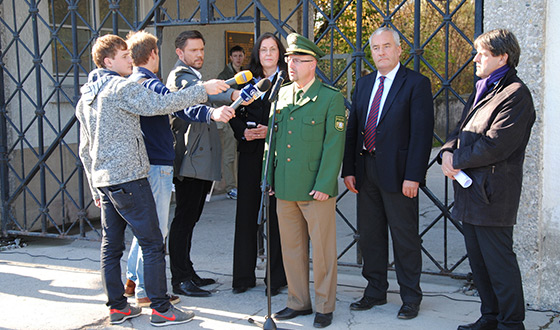
Press briefing on the theft of the gate with Dr Gabriele Hammermann, director of the Dachau Concentration Camp Memorial Site, police director Thomas Rauscher, head of the Dachau police branch, and Dr Ludwig Spaenle, Culture Minister (from left to right), November 2014 (Dachau Concentration Camp Memorial Site)
2015
On the seventieth anniversary of the liberation of the Dachau concentration camp, around 130 former prisoners and liberators, accompanied by their families, take part in the commemorative ceremonies. The Federal Chancellor Dr Angela Merkel thanks the survivors for their involvement in education programs as contemporary witnesses and commemorates the dead of the Dachau concentration camp.
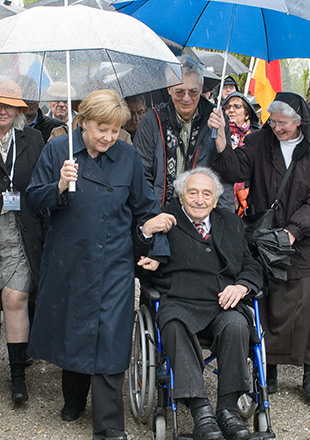
Dr Angela Merkel with the survivor Max Mannheimer (Sebastian Freller)
2017
On February 22 2017, the stolen gate with the inscription “Arbeit macht frei” returns to the Dachau Concentration Camp Memorial Site. The gate was found in a carpark in the Norwegian city of Bergen. It is being restored and will be presented in a display case as part of the main exhibition.
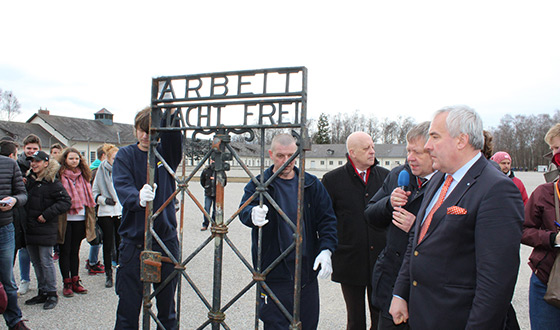
Press briefing on the return of the gate with the CID president Jean Michel Thomas, Foundation director Karl Freller, and Culture Minister Dr Ludwig Spaenle (from left to right), February 22 2017 (Dachau Concentration Camp Memorial Site)

